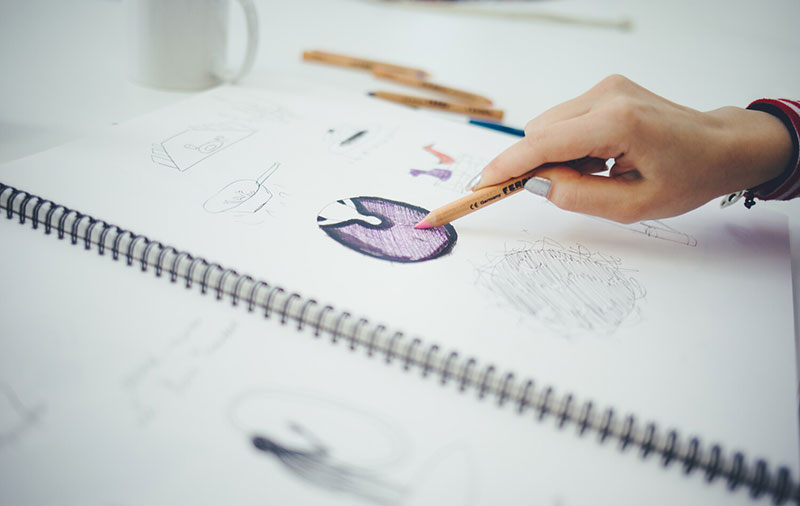How to Make an Art Portfolio: Guide with Tips & Examples (2023)

An art portfolio is a collection of work that showcases your skills, personality and creative potential.
In the selection process for entry to art and design schools, it is more important than the number of GCSEs and A-levels you have, or the grades you achieved (or equivalent qualifications if you completed high school outside the UK).
Your artist portfolio will open the door to excellent art schools if you can show:
- high quality original work
- the thought process that took you to the final work
- versatility in your use of different art media and techniques
Below, we look more closely at what an art portfolio consists of, what makes a good one, and why it is so important to have.
Table of Contents
Why does having an art portfolio matter?
4 tips for creating a great art portfolio
4 examples of successful art portfolios
How to make an art portfolio in 5 simple steps
What is an art portfolio?
An art portfolio is a collection of projects which best represent an artist’s work.
Depending on the media used, a portfolio can include actual artwork, web links to artwork or a photographic documentation of the artwork. So, hardcopies of 2D work like original fine art could be included as well as sketchbooks, pencil drawings, small sculptures, prototypes of clothes in fashion design, links to game designs, links to online hosted digital media like web design, animations and film.
Like a Curriculum Vitae, which can be changed depending on the job you are applying for, an art portfolio can showcase original artwork relevant to the specifics of an art school application, an art commission or potential clients.
Why does having an art portfolio matter?
An art portfolio is a showcase of your body of work and shows your artistic skills, technical ability, and overall, what kind of artist you are. Below are some of the reasons why it's so important to have one.
Reason #1: An art portfolio is a historical checklist of your work as an artist
A good art portfolio will show work over a period of time, not just recent work.
This will highlight your evolution as an artist, the formation of an individual style through experimentation.
Reason #2: It helps you demonstrate your identity as an artist
Your artistic identity is the sum of all the influences, your thought processes, likes and dislikes, and the original way you decide to express all of this.
To make sure your portfolio shows your identity as an artist, you should showcase not just the final work but the process that took you to it: studies, mood boards and textual explanations should accompany the final pieces.
Reason #3: It helps you stand out from the crowd
More than high school qualifications, curating a well documented and varied art portfolio will be key when you need to stand out from the crowd and showcase your best work.
Art schools will look at academic background but the portfolio is the most important part of your application.
This is not just true of an educational application. When applying for an art commission or in applying for a job, your portfolio will be what will determine you as a winning candidate, showcasing your creativity and innovation as an artist.
Reason #4: It’s essential if you want to apply for an arts programme
No art school admissions officers will even consider your application if you can’t show a portfolio.
Depending on the art program you want to apply for, you might want to showcase more of a type of media/art form but generally, an art school portfolio showing versatility, knowledge of your influences and thought process is the strongest.
Reason #5: It’s essential if you want to participate in exhibitions
If you want to take part in an exhibition, you will need to send a comprehensive portfolio of your own work to the organisers.
If you use different media and the exhibition focusses on a particular subject matter and media, it might be good to create a specific portfolio for the application that highlights your strengths in the areas explored by the exhibition, with links to other work that don’t go in as much detail.
4 Tips for a great art portfolio
Here we explore some of the practical tips to get your portfolio in perfect shape.
Tip #1: Go through the art portfolio criteria
Make sure you read through any specific requirements for the portfolio to apply for a university or art school. Portfolio needs and requirements do vary from place to place.
Visit their website to find portfolio requirements and make sure you tick all the boxes: what size, what format they accept, what types of supporting documentation they need.
Tip #2: Tell engaging visual stories
In Art there are infinite ways to develop and represent ideas and problems and there is no right or wrong way, but there are certainly more successful ways of representing your concepts.
Bear in mind too that it can also be good to show the unsuccessful ideas; the ideas you decided to discard in favour of the final idea. Showing experimentation within portfolio pieces, as well as the final work will make you stand out.
Tip #3: Choose your work examples wisely
Choose the best examples of your work. Showcase knowledge of different media, technical skill and indicate useful influences and sources.
It’s worth noting that most art and design courses require applicants to have a certain level of observational drawing skill. This is essential not just for Fine Art specialities, but for many others, such as Architecture and Fashion Design. Even degrees that do not seem to obviously focus upon drawing usually welcome the inclusion of this within an application portfolio.
Tip #4: Get feedback
Once you are happy with the portfolio, check with your art teacher, artists or even friends whose opinion you trust. They are your first audience and they might spot something missing or something you might be better off omitting.
At Kings, tutors at the School of Art + Design will make sure you have the best portfolio to apply for the art and design degree you want to progress to, for example graphic design, interior design, digital media, visual arts, printmaking - there are so many different specialisms. We also run portfolio workshops with university faculty once or twice a year.
4 Examples of successful art portfolios
A successful portfolio is a collection of your artwork that presents a full picture of you as an artist and gives the audience an idea of your skill set, and the breadth of ideas, creativity, techniques which define you.
Below are some portfolios which we think are really successful in presenting an artist’s past work, current projects and the type of work they excel in.
Example #1: Leta Sobierajski
An example of a very advanced online portfolio, Leta uses Cargo to showcase her multifaceted artistic output.

Example #2: Batec Animacion
This Barcelona-based studio showcase their production through the Carbonmade portfolio platform.

https://batecanimation.carbonmade.com/
Example #3: Kim Heejae
Heejae is an illustrator, design and art director based in Los Angeles. His website displays the projects he has worked on, with a short introduction before displaying lots of photos of the work.

How to make an art portfolio in 5 simple steps
Now let’s break down the process of making an art portfolio in 5 simple steps.
Step #1: Make a list of the art portfolio requirements for all schools you want to apply to
Make sure you know precisely what the art portfolio requirements are and make sure you know how to satisfy them.
Step #2: Get inspiration from recent art portfolio examples
Ask your tutor if they can show you some examples of successful art portfolios. You can also visit the main digital art portfolio portals and have a good browse through the top portfolios they host:
Step #3: Organise your work examples effectively
Make sure the display of your work follows an evolution or that you prioritise the work you are closest to and that you want to highlight.
Step #4: Make sure all your work is properly labelled
Each piece of work must be labelled clearly with a name (even if the name is Untitled!), a date, the materials used and possibly a short paragraph about the influences, origin and process that got you to the final version. Use small, clear writing to label work in a way that doesn’t detract from the artwork.
It's also important to proof for spelling errors and inaccuracies, and to make sure any digital links work.
Step #5: Revisit and improve your portfolio
Make sure your portfolio is always current, even if it includes work from a few years earlier. You need to make sure the older work fits into the overall presentation of the portfolio, so for example, keep the label and introduction copy updated.
Frequently Asked Questions (FAQs)
Q1. What size should an art portfolio be?
The size of a portfolio will depend on the breadth of your work and the audience you are addressing. The fuller a portfolio and the more pieces of art within it, though, the better as - even if you are applying for a degree in animation for example - it will be useful to showcase your work on media that might not be directly related to that.
Q2. How do I create an online art portfolio for free?
There are lots of online platforms which specialise in creating artist portfolio websites. Most of them provide good free plans and double up as talent recruitment platforms. Behance is the most popular one, followed by Dribbble. Coroflot and Cargo are excellent platforms too.
Q3. What should be included in an art portfolio?
An art portfolio should include as many examples as possible of work you are happy with, and ideally different forms of art. You should as much as possible show the research and influences and the thought process behind the final work, so sketches, studies, photos, some textual explanation.
Next Steps
At the Kings School of Art + Design we offer a range of courses that will give you an opportunity to experiment with a wide range of art specialisms and techniques to understand what specific path your art education will take. We will also support you extensively in creating an art portfolio to apply for places at the best Art Schools in the UK.
Find out more about the Kings School of Art + Design programmes:
- UAL Foundation Diploma in Art and Design
- Art & Design Foundation
- A-level Art & Design
- Fast-track Art and Design Pathway
If you would like more detailed information about the Kings and our programmes, please get in touch with us at enquiries@kingseducation.com.




